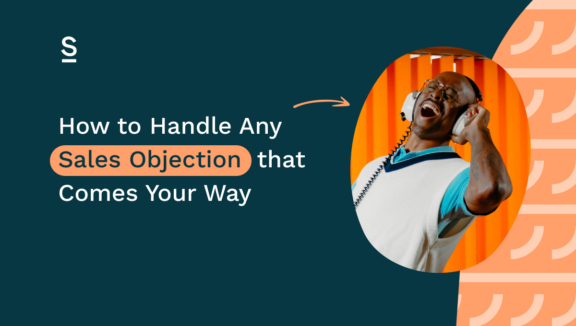How to Handle Any Sales Objection that Comes Your Way

Handling a sales objection is a bit like climbing a really, really steep rock face.
Glory awaits if you make it to the top. One misstep, however, and you come crashing back to earth – or in other words, the sale’s lost.
Every difficult climb has a particularly challenging part – and for sales professionals, the inevitable challenging part is the sales objection.
60% of customers say no four times before they say yes. It’s rare that you’ll make a sale without having to handle at least one objection – it’s part and parcel of the job.
The good news? Just like talented climbers become better-practiced at handling those tricky bits, you as a sales professional can become better at handling objections.
This article’s going to show you how to do just that.
After finding out more about what objections are and why they happen, we’re going to run through the soft skills and different techniques you can use to handle any objection like a pro. We’ll then move on to common objections and give you answers to use when you need them.
By the end, you’ll be the sales equivalent of a professional rock climber. And who doesn’t want to be a professional rock climber?
Skip ahead:
- Understanding sales objections
- Soft skills you need to handle objections
- Objection handling techniques
- Addressing the most common sales objections
Got your climbing ropes at the ready? Good – let’s get started.
Understanding sales objections
What are sales objections? Simply put, an objection is the reason your prospect gives for not being able to go ahead with the sale.
Some experts choose to divide objections into four categories:
- Price: the product is too expensive
- Need: they’re not sure if it does what they need
- Trust: they’re unsure about what your business can deliver
- Stalling: they need more time or to involve another decision-maker
These categories can be a useful guideline, but to be honest – objections can come from anywhere and everywhere. Sometimes you’ll see them coming, and other times they’ll sneak up on you when you least expect it.
Whatever the objection, and whenever it shows up, it’s vital to be able to handle it. There’s the obvious reason – your job is to close sales, and the objection is in the way of you doing your job – but that’s not all. You also need to think about what happens later down the line.
Say you close a deal, but you didn’t handle an objection super effectively. Your prospect, who’s now going to be your point of contact as a customer, still doesn’t feel 100% sold on your product.
That’s not an ideal start to the relationship: your CS team will have a harder time gaining their trust and it might make renewal more difficult. And as we know, churn isn’t good for your bottom line.
Say the deal doesn’t close because you handle an objection really badly (no offense – it does happen!). That’s a prospect that’s going to be far more difficult to re-engage later on. Their business could even be a slice of market share that’s lost forever.
The long and the short of it is, neither situation is ideal. Overcoming sales objections – from the super common to the weirdest of weird – is important. Let’s get into it.
Soft skills you need to handle objections
Any good salesperson has strong soft skills – at the end of the day, sales is a people-focussed role. There are two that particularly come into play when handling objections:
Empathy and active listening
Feel empathy for your prospect, and you feel compassion and understanding. It’s the opposite of getting frustrated or impatient when they object. People object because they’re worried – and it’s up to you to understand where they’re coming from, and make the effort to make them feel better.
How do you understand where these worries are coming from? By practicing active listening. Most people listen so they can respond. Practice active listening, and you detach these two. You’re listening only to understand your prospect’s concerns. Responding comes once you’re fully confident you understand where your prospect is coming from and why they are worried.
Short term, practicing these sales skills is going to build rapport between you and the prospect. If you’ll let us go all hippy on you for a moment, you’ll understand your prospect’s needs on a deeper level. 🧘♂️ Long term, it’s going to make you better at your job. The better listener you are, the more you understand your customers, the faster you can sell to them. Happy days. 🌞
Let’s take an example. Our first salesperson, Bill, hears a common objection from his prospect: the solution he’s suggesting is too expensive. Bill gets frustrated – yes, it’s expensive, but it’s also the best. What’s the problem? – and doesn’t put care into his answer.
He dives into all the reasons why his product is better than the cheaper competitors out there. His prospect takes the case to the decision-maker – who says no.
Then let’s rewind – and turn Bill into Jill, our second salesperson. Jill listens to the price objection. She pauses, and asks the prospect to elaborate. From their answer, she understands that the prospect isn’t looking for the best solution out there. They’re looking for the best solution for their business.
She suggests they try a cheaper ‘starter’ package, knowing that the CS team can upsell once the business has grown. The decision-maker loves this suggestion – it’s in-budget, and does what they need it to do.
Jill closes the sale, wins the admiration of her team and manager, and gets a nice bonus. Bill sulks in the corner.
Preparation and knowledge
The other side of the coin is preparation and knowledge.
You need to go into each call fully prepared: that means knowing your product (obvs) and knowing the prospect’s business inside out. Have a good look on LinkedIn, comb through their website, check out their financials and make sure you’re up-to-date on what’s happening in the industry.
The beauty of all this research is you can then use it to customize each sales pitch to the specific needs of the prospect. You understand an industry change that will impact their business, and use tips on overcoming the problem as part of your outreach. You understand what your prospect’s role involves, and use that knowledge when explaining the details of your product.
Plus, the more prepared and knowledgeable you are the more confident you’ll feel. And we all know that translates into an easier call – for you, and for the prospect.
Objection handling techniques
Let’s go back to our climbing analogy for one sec. The best climbers will use a variety of different techniques: you’ve got different ways to position your feet and hands, different ways to move…and the same goes for handling sales objections.
With the right techniques at your disposal, you’ll be able to nimbly traverse any customer objection that comes your way.
Feel, felt, found method
We like this one as it gives you a chance to practice empathy and active listening. Listen to the objection, and think about how a current customer has found the opposite to be true.
Start by telling them that you know how they feel, before explaining that someone else has also felt this way. Here you’re making the prospect feel understood and giving them someone to relate to (bonus points if it’s a customer they will have heard of).
Next, tell them about how the person found the opposite to be true. To take a really basic example, say the prospect’s worried about the technical implementation. You could say you understand because a previous customer (insert name drop here if you can) was also concerned about how complicated it would be.
You can then explain how you made it super easy for them by getting your engineers to do the heavy lifting – and in the end, it wasn’t as nearly time-consuming as the now-customer first thought. Job done.
Data and proof
Use concrete evidence to support your claims – otherwise you risk sounding like you’re *ahem* being a little economical with the truth.
Do this well, and it can be an opportunity to build even more trust with social proof, case studies or testimonials. For example, if a prospect’s concerned about ROI, you could explain that another customer experienced a 3X return on their initial investment. Job done.
Live demos are also a great way to handle common objections. Objections come from the unknown – so make your product as known as possible, and you’ll be onto a winner.
Creating urgency
If your prospect seems to be stalling, or a new decision-maker pops up out of nowhere during the final stretch, you can create a sense of urgency: just emphasize the costs of inaction and the benefits of timely decisions.
A word of warning: don’t over-pressure here. What do you do when you feel pressured or claustrophobic? You rebel, or try to get out. And that is not the effect we’re looking to achieve here.
Addressing the most common sales objections
Ok, we’ve done the groundwork. Time for common objections, and answers you should steal:
Price objections
The classic: some variation of “it’s too expensive for us”.
Hear them out (we’d recommend pausing after they say this, to see if they elaborate on the real reason why it’s too expensive). Next, you could try:
Reframe the focus from the cost to the value of your solution: ‘What will it cost you to do nothing?”
Emphasizing ROI: “What’s the ROI you’re looking to see?” or “You’re right, it is expensive. The most impactful products always are”
Offering flexible pricing: “Let’s see how we can make this fit into your budget”
Time and resource constraints
Your prospect’s told you they don’t have enough time to introduce a new product, or perhaps they don’t have the manpower to implement it. Try:
Offering implementation support: “I hear you. Our other customer was worried about the same thing, but the support we offer takes the input needed from you down to three hours.”
Highlighting how your product saves time and resource long-term: “Here’s the timeline for ROI if we start next quarter. How does that sound?”
Trust and credibility
You can sense your prospect doesn’t feel fully confident in the solution you’re offering. Here’s how to handle it:
Building trust: “I understand what you’re saying. Let me take a minute to walk you through what we did with [relevant customer].”
Demonstrating industry expertise: “Let me walk through my understanding of the challenges your role faces, and you can tell me what I’ve got right and wrong.”
Competition
If you’re in a crowded market or you’re a challenger brand, you’re likely to hear pushback regarding your competitors. Respond by:
Differentiating from your competition: “What is it about your current solution that you like the most? I’d love to see how we compare.”
Showing you understand your competitors: “[Competitor] does x, y and z. We do z slightly differently, for this reason…”
Let’s wrap it up!
Objections may seem scary when they first appear – but if you think of them as an opportunity to form a deeper connection with your prospect, they start being exciting. Start with a good foundation of knowledge, keep your techniques to hand and make sure your common objection answers are front of mind, and you’ll be able to handle any objection that comes your way.
Just call yourself the Alex Honnold of B2B sales.

Ready to put your objection-handling skills to good use?
Use Surfe to find prospects to practise on. It uses LinkedIn to find contact data, automatically syncs it to your CRM, and updates things where necessary. And it won’t cost you a penny to try.
FAQs about overcoming common sales objections
How important is empathy in the sales process?
Empathy is extremely important in the sales process. Without it, you can’t say you fully understand where the objection is coming from – and if you don’t understand your customers’ concerns, you’re not doing the best job you could be. Practice active listening to make sure you’re being empathetic in your answers to objections, and you’ll build a stronger relationship with your prospects.
How do you prepare for sales calls to anticipate and address objections?
You should prepare for objections during sales calls in two ways:
- Do your research: look into your prospect and their business on LinkedIn, on their website and on the news to really understand who they are and what their pain points might be.
- Customization: make your pitch unique and address common objections you feel will come up before the prospect has a chance to make them.
What is the ‘feel, felt, found’ method?
The ‘feel, felt, found method is a common objection-handling technique that sales reps use when faced with an objection. They acknowledge how the prospect is feeling and then explain that a previous prospect has felt this way before. They then move on to explain how the prospect found that they actually did not need to worry about this specific concern.
How do you handle price objections specifically?
Price objections can be handled in a number of ways, including using open-ended questions:
- Shift the focus to the value of your product, so they see what they gain rather than what it will cost
- Emphasize the ROI of the product, so they can see what returns they’ll get on their initial investment
- Offer flexible pricing, by removing aspects of the product or service, offering a discount for a longer contract, or moving them onto a cheaper package


